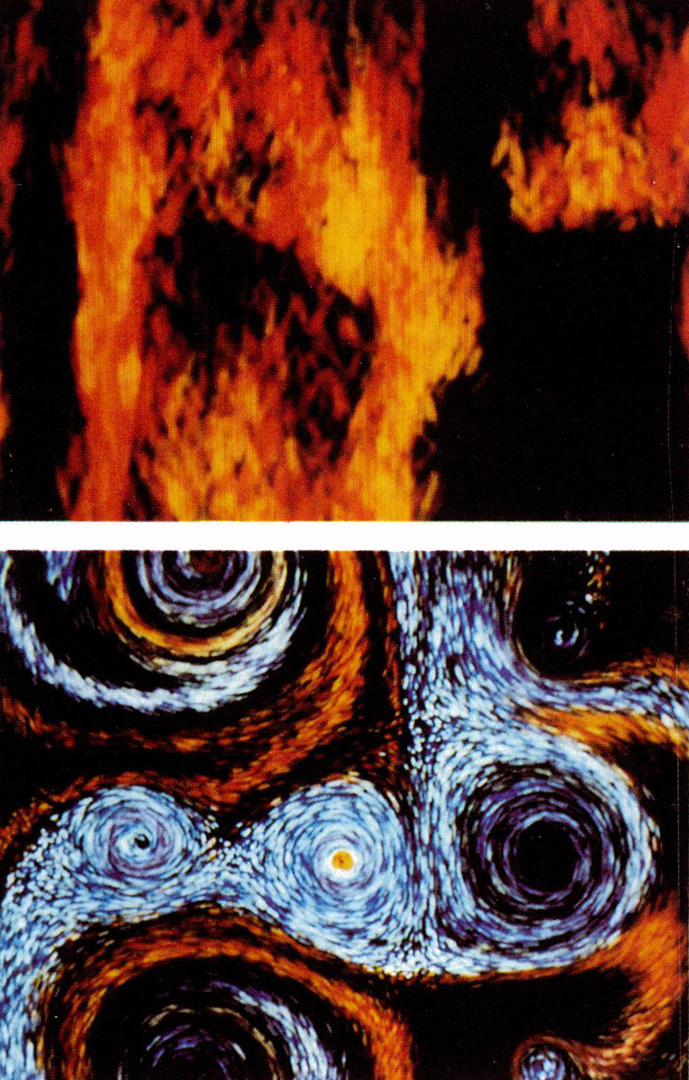“Particle animation and rendering using data parallel computation” by Sims
Conference:
Type(s):
Title:
- Particle animation and rendering using data parallel computation
Session/Category Title: Pools, Puddles, Stones, Waterfalls and Fire
Presenter(s)/Author(s):
Moderator(s):
Abstract:
Techniques are presented that are used to animate and render particle systems with the Connection Machine CM-2, a data parallel supercomputer. A particle behavior language provides an animator with levels of control from kinematic spline motions to physically based simulations. A parallel particle rendering system allows particles of different shapes, sizes, colors and transparencies to be rendered with antialiasing, hidden surfaces, and motion-blur. One virtual processor is assigned to each primitive data element: one to each particle, and during the rendering process, one to each pixel-sized particle fragment, and to each pixel. These tools are used to model dynamic phenomena such as wind, snow, water, and fire.
References:
1. Armstrong, W., Green, M., “The Dynamics of Articulated Rigid Bodies for Purposes of Animation,” Proceedings Graphics Interface ’85, pp. 407-415.]]
2. Amburn, P., (}rant, E., Whitted, T., “Managing Geometric Complexity with Enhanced Procedural Methods,” Computer Graphics, Vol. 20, No. 4, August 1986.]]
3. Barr, A., Barzel, R., “A Modeling System Based on Dynamic Constraints,” Computer Graphics, Vol. 22, No. 4, 1988, p. 179.]]
4. Carpenter, L.C., “The A-buffer, an Anti-aliased Hidden Surface Method,” Computer Graphics, Vol. 18, No. 3, 1984.]]
5. Fournier, A., Reeves, W., “A Simple Model of Ocean Waves,” Computer Graphics, Vol. 20, No. 4, 1986, pp. 75-84.]]
6. Girard, M., Maciejewski, A., “Computational Modeling for the Computer Animation of Legged Figures,” Computer Graphics, Vol. 19, No. 3, 1985, pp 263-270.]]
7. Hahn, J. K., “Realistic Animation of Rigid Bodies” Computer Graphics, Vol. 22, No. 4, 1988, p. 299.]]
8. Hillis, W. D., The Connection Machine, MIT Press, 1985.]]
9. Hillis, W. D., “The Connection Machine,” Scientific American, Vol. 255, No. 6, June 1987.]]
10. Lasser, C., Massar, J.P., Mincy, J., Dayton, L., “Starlisp Reference Manual,” Thinking Machines Corporation, 1988]]
11. Lucasfilm Ltd, The Adventures of Andre and Wally B., (film), August 1984.]]
12. Miller, G., “The Motion of Snakes and Worms” Computer Graphics, Vol. 22, No. 4, 1988, p. 169.]]
13. Oppenheimer, P. “Real time design and animation of fractal plants and trees. Computer Graphics, Vol. 20, No. 4, 1986, pp 55-64.]]
14. Paramount, Star Trek ii: The Wrath of Kahn, Genesis Demo, also in SIGGRAPH Video Review 1982, ACM SIGGRAPH, New York.]]
15. Peachy, Darwyn R., “Modeling Waves and Surf,” Computer Graphics, Vol. 20, No. 4, 1986, pp. 65-84.]]
16. Platt, J., Barr, A., “Constraint Methods for Flexible Models,” Computer Graphics, Vol. 22, No. 4, 1988, p. 279.]]
17. Press, Flannery, Teukolsky, and Vetterling, Numerical Recipes, Cambridge University Press, 1986, p. 248.]]
18. Prusinkiewicz, P., Lindenmayer, A., and Hanan, J., “Developmental Models of Herbaceous Plants for Computer Imagery Purposes,” Computer Graphics, Vol. 22 No. 4, 1988, pp. 141-150.]]
19. Reeves, W. T., “Particle Systems- A Technique for Modeling a Class of Fuzzy Objects,” A CM Transactions on Graphics, Vo}. 2, No. 2, April 1983, reprinted in Computer Graphics 1983, pp. 359-376.]]
20. Reeves, W. T., and Blau, R. Approximate and probabilistic algorithms for shading and rendering structured particle systems. Computer Graphics, Vol. 19, No. 3, 1985, pp 313-322.]]
21. Reffye, P., Edelin, C., Francon J., Jaeger, M., Puech, C. “Plant Models Faithfid to Botanical Structure and Development,” Computer Graphics Vol. 22, No. 4, 1988, pp 151-158.]]
22. Reynolds, Craig W., “Flocks, Herds and Schools: A Distributed Behavioral Model,” Computer Graphics, Vol. 21, No. 4, July 1987, pp 25-34.]]
23. Simon, H.D., Scientific Applications of the Connection Machine, World Scientific Publishing Co., 1988.]]
24. Sims, K., Particle Dreams, SIGGRAPH Video Review 1988, ACM SIGGRAPH, New York.]]
25. Smith, A. R., “Plants, Fractals, and Formal Languages,” Computer Graphics, Vol. 18, No. 3, pp. 1-10, July 1984.]]
26. Studio Base 2, Systeme Particulier, Chesnais, Alain, SIGGRAPH Video Review 1987, ACM SIGGRAPH, New York.]]
27. Symbolics, Stanly and Stella in Breakin9 the Ice, SIG- GRAPH Video Review 1987, ACM SIGGRAPH, New York.]]
28. Terzopoulos, D., Fleischex, K., “Modeling Inelastic Deformation: Viscoelasticity, Plasticity, Fracture,” Computer Graphics, Vol. 22, No. 4, 1988, p. 269.]]
29. Thinking Machines Corporation, Connection Machine Model CM-2 Technical Summary, technical report, May 1989.]]
30. Weil, J., A T & T Bell Labs, Boom Boom Boom, SIG- GRAPH Video review 1987, ACM SIGGRAPH, New York.]]
31. Wilhelms, J. Baxsky, B., “Using Dynamic Analysis for the Animation of Articulated Bodies Such as Humans and Robots,” Proceedings Graphics Interface ’85, pp. 97-104.]]
32. Wilhelms~ J., Moore, M., “Collision Detection and Response for Computer Animation,” Computer Graphics, Vol. 22, No. 4, 1988, p. 289.]]
33. Yaeger, L., Upson, C., “Combining Physical and Visual Simulation – Creation of the Planet Jupiter for the Film 2010,” Computer Graphics, Vol. 20, No. 4, 1986, pp 85- 93.]]




